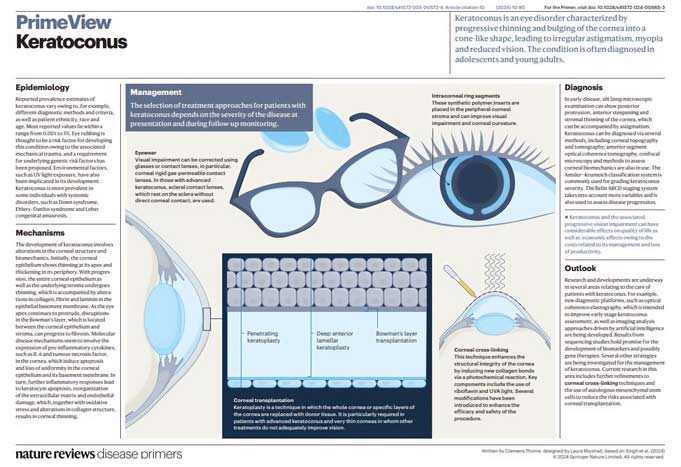The Complexity of Keratoconus and Its Aetiology
Keratoconus primarily affects adolescents and young adults, characterized by a progressive weakening of the cornea that results in corneal thinning and cone-like steepening, which leads to increasing irregular astigmatism and vision impairment. The review highlights the complex aetiology behind keratoconus, including genetic, environmental, biomechanical, and cellular factors. The article highlights how environmental influences like eye rubbing and UV light exposure are associated with disease progression, and emphasises the importance of people not rubbing their eyes.
Cellular Mechanisms and Their Role in Keratoconus
On the cellular level, keratoconus involves disruptions in biochemical pathways that affect endogenous collagen cross-linking processes in the corneal stroma, leading to the corneal structure’s distortion. Hormonal changes and can further exacerbate structural instability.
Diagnosis and Monitoring through Advanced Imaging
Clinical diagnosis of keratoconus has improved with the introduction of advanced imaging technologies such as Placido disk and OCT-based corneal topographers and tomographers. These tools allow for early detection and more precise disease progression monitoring and help clinicians personalize keratoconus treatment plans based on disease severity and progression rate.
Tailored Treatment Options for Keratoconus
Treatment strategies vary based on the disease stage. In early keratoconus, glasses or soft contact lenses may correct vision. As keratoconus progresses, patients often require rigid gas-permeable or scleral lenses for improved visual acuity. The most significant advancement in keratoconus treatment in the last two decades was the introduction of corneal cross-linking (CXL), which increases the strength of the cornea, stabilising the shape of the cornea and preventing further ectasia.
For advanced cases with corneal scarring or when contact lenses are intolerable, surgical interventions become necessary. These surgical options provide a last line of defense in restoring vision for individuals severely affected by keratoconus.
The review, published in the prestigious Nature Reviews Disease Primers, reflects the field of medicine’s recognition of keratoconus as an important and complex, multi-dimensional disease. The article is available to read here.

